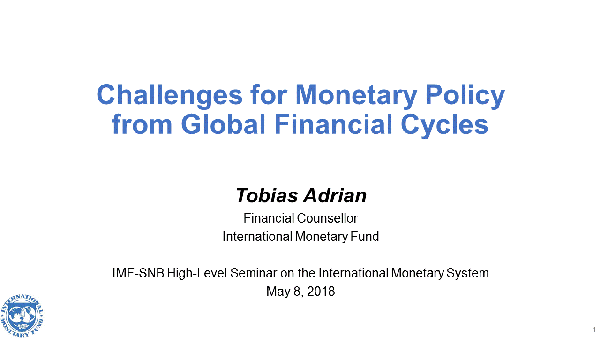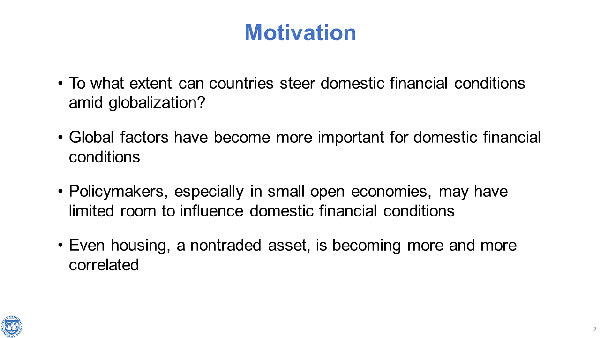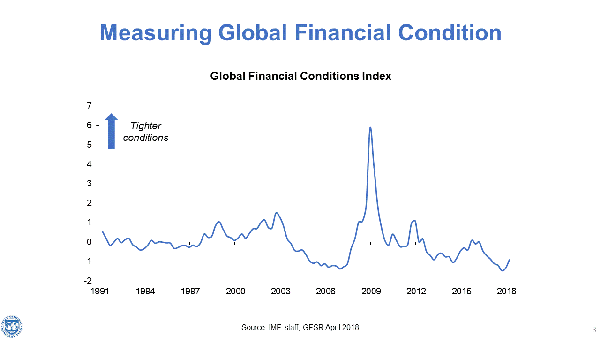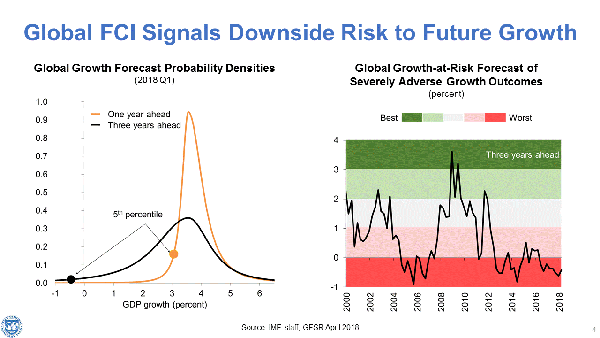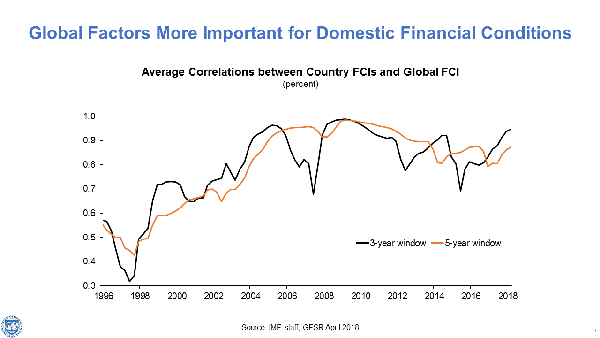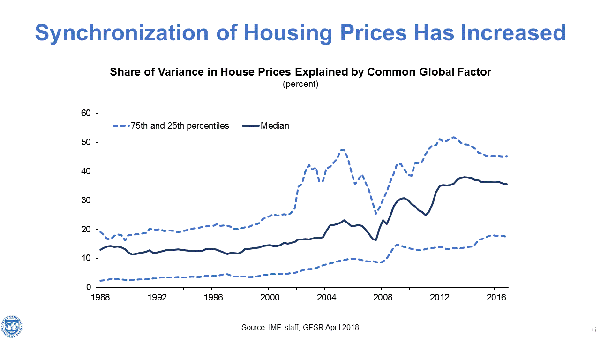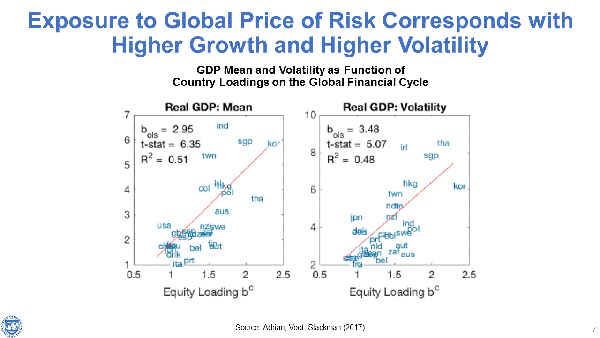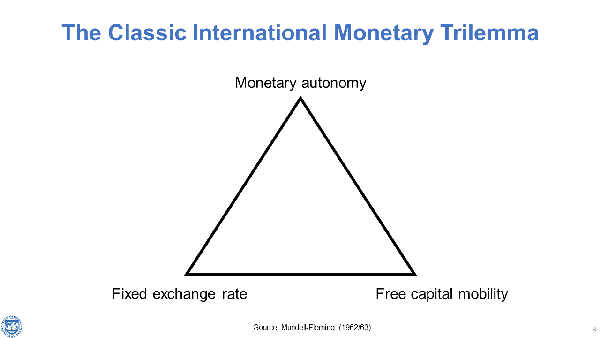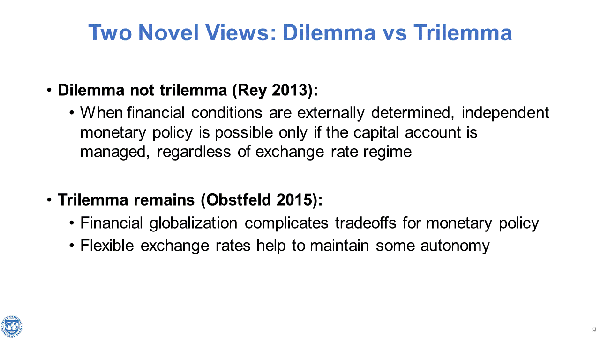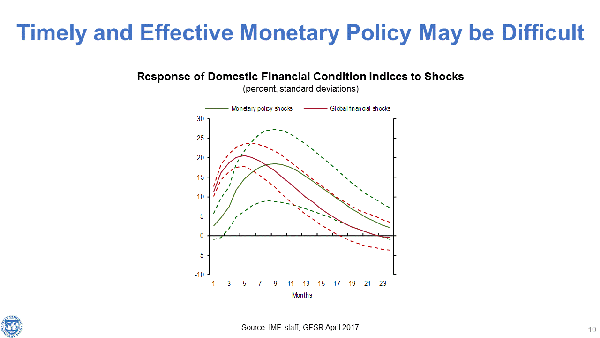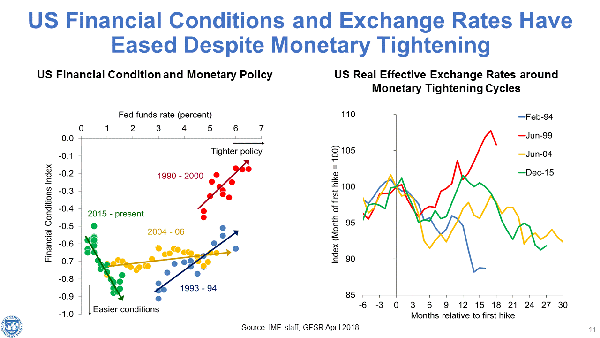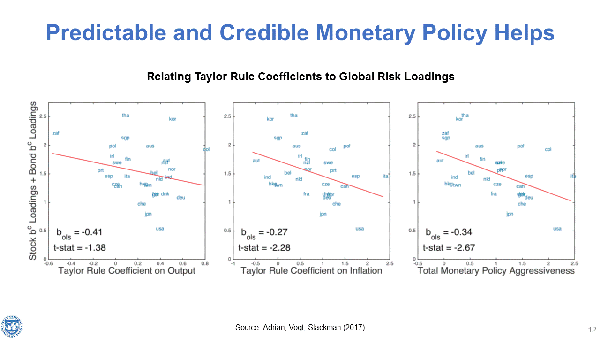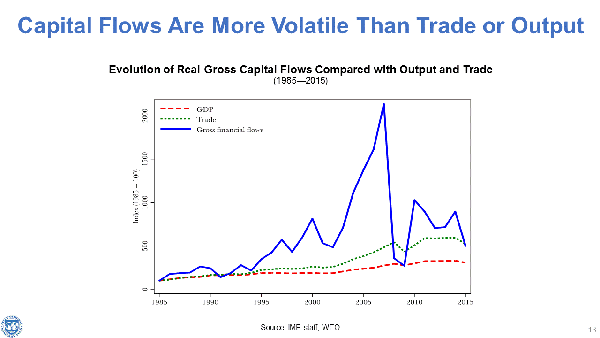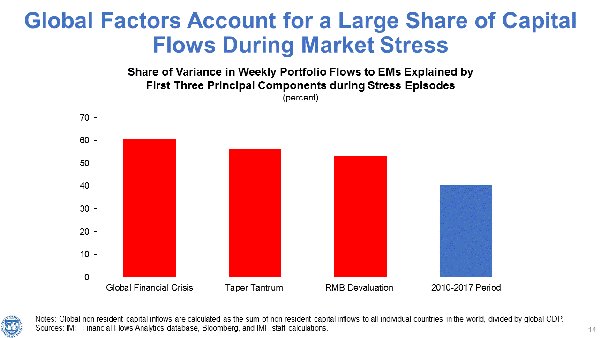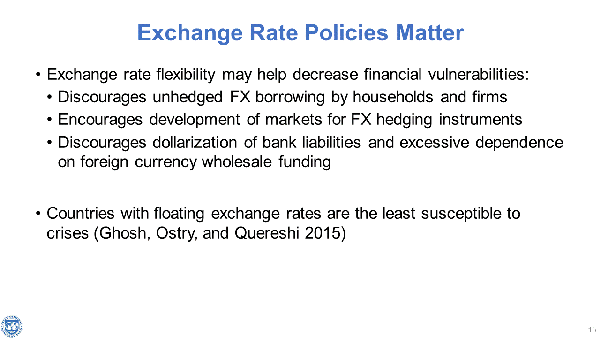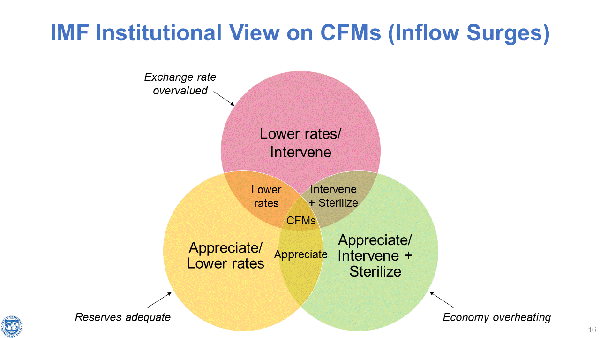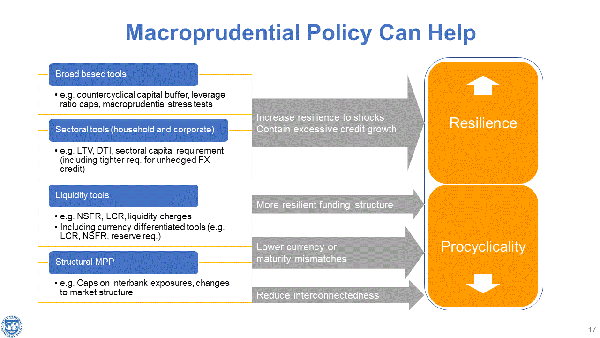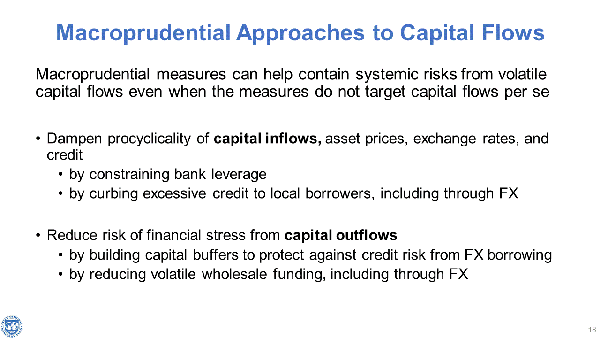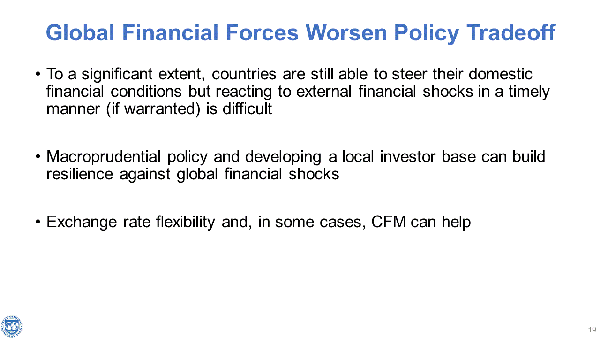Challenges for Monetary Policy from Global Financial Cycles
May 8, 2018
Good morning, ladies and gentlemen.
It’s a great pleasure to join you here today. Let me express my thanks to Thomas Jordan, the Governor of the Swiss National Bank, for his welcoming remarks. And let me extend my thanks to all of you for joining us at this important conference: the eighth time that the SNB and the IMF have convened some of the world’s leading authorities in monetary policy.
Throughout today’s conference, we’ll hear from a distinguished array of experts—and we’re all looking forward to this afternoon’s concluding remarks by the Managing Director of the IMF.
As we prepare to hear from the members of this morning’s first panel, I’ll offer some opening remarks to frame our discussion along three dimensions.
First, I will explore key aspects of the global financial cycle—that is, global fluctuations in financial activity (Miranda-Agrippino and Rey, 2015).
Second, I will assess its importance in influencing cross-border capital flows.
Finally, I will discuss its role in shaping monetary policies around the world.
Let’s begin by setting forth the challenge faced by policymakers, in economies large and small: steering domestic financial conditions in an environment where capital flows are global and mobile.
Global factors have indeed become important drivers of domestic financial conditions.
“No man is an island entire of itself,” wrote the poet John Donne . . . and no economy, in this era of globalized markets—when capital can move at the speed of electrons—can imagine that its individual monetary policy can be determined independently from global financial conditions.
That concern is especially acute for policymakers in small, open economies and emerging markets—because they have only limited ability to influence domestic financial conditions.
Amid our most recent research at the IMF, we’ve found that this reality affects not just financial assets, which are easily traded across borders, but also fixed assets that are non-tradable. As we described in a chapter of our most recent Global Financial Stability Report —the “GFSR”— international flows of capital are wide-ranging as global investors search for yield . . . so much so, that even housing prices have become more correlated across countries (IMF 2018a).
That’s especially true for housing in so-called “global cities”—including Zurich—that are international financial centers.
The challenge for policymakers is all the more difficult, because measuring financial conditions is not a straightforward task. A host of financial variables convey information, “in real time,” about financial conditions.
In our construction of global financial conditions, we eliminate the influence of real-time economic factors—such as fluctuations in GDP growth—to get a realistic measure of ever-changing financial conditions.
In this chart from our most recent GFSR (IMF 2018b): We show one such index—the “Global Financial Conditions Index,” or “FCI”—that is based on many variables. Considering that a higher value of FCI means tighter financial conditions, the chart depicts the sharp year-by-year change in global financial conditions.
These charts depict our most recent measurements using our “Growth-at-Risk” methodology, which we described in detail in our previous GFSR, last October—and which we used in this spring’s report (IMF 2018b). You can see here how, currently, the Global FCI measures the downside risks to GDP.
Those downside risks to GDP are measured as the “left tail” of the probability distribution—that is, the 5th percentile of the distribution. These look at the one-year ahead, and the three-year-ahead, distributions of cumulative GDP growth.
On the left-hand chart—looking at the distribution depicted by the yellow bell-shaped curve—our calculations show that the one-year-ahead downside risks to GDP are low. There is only an estimated 5 percent probability (based on what we know today) that GDP growth will be lower than 3 percent
However: It’s a different story when you look at the black bell-shaped curve: It shows that—in the three-year-ahead view—the downside risks are much more significant. In that three-year timeframe, growth is projected to be negative with a 5 percent probability. The “tail” has moved decidedly to the left.
That’s our latest calculation of “Growth-at-Risk.”
In the right-hand chart, you can see the time series of the three-year-ahead measurement of Growth-at-Risk. Currently, growth in the severely adverse scenario three years ahead is very low by historical standards.
Loose financial conditions today are associated with a larger downside risk to GDP three years into the future. Thus, at our Spring Meetings in Washington last month, we found that risks—over the three-year horizon—are now elevated.
Broadly speaking: Global factors are today more important as a driver of domestic financial conditions than they were 20 years ago. This chart—looking back to the late 1990s, with data from more than 40 countries—shows the average correlation of domestic FCI with the Global FCI. That correlation increased sharply between 1998 and 2005.
Let’s consider the case of house-price synchronization, which I mentioned a moment ago. House prices have become more synchronized across countries in the last 20 years, amid the trend toward lower global interest rates (IMFa).
The consequences of such a rise in synchronicity are not necessarily bad. It could signify that housing and mortgage markets have become more liquid, allowing prices to become more aligned with economic fundamentals.
However: There is a good reason for policymakers to be concerned by this trend. Greater synchronicity may signal a stronger likelihood that external shocks could be transmitted to local housing markets.
Thus: Local markets might have become more sensitive to global financial conditions. The strength of local markets is critical to the smooth functioning of every nation’s financial systems, and housing markets have broad implications for financial stability: Housing purchases are often financed with mortgages. So, any increase of local vulnerability to external shocks could be worrisome.
Meanwhile: There is also a strong association between a higher exposure of domestic asset prices to global financial conditions and higher macroeconomic volatility.
When we look across countries, we see a striking pattern. As you can see in these charts from Adrian, Vogt, and Stackman (2016): Those countries where equity prices correlate more strongly with a global risk factor, they tend to have higher GDP growth and higher GDP volatility. This suggests a risk-return tradeoff: more exposure to global financial conditions means higher growth, but also higher risk.
So, if these global financial factors are increasingly important, do they pose constraints on policymaking? How have policymakers thought about such constraints?
The classic approach to the external constraints on macroeconomic policy has been summarized by the contributions of Mundell (1963) and Fleming (1962).
The “Mundell-Fleming Trilemma” encapsulates a fundamental constraint: Only two of the following three factors are compatible:
- Exchange-rate stability;
- Asset markets that are open to trade; and
- Domestic monetary autonomy
Of course, one can trade objectives off, one against the other: For example, you can have more foreign-exchange intervention, but that might come at the expense of have less traction on domestic monetary-policy goals.
But Robert Mundell and Marcus Fleming are quite clear: You can choose any two of those objectives—but you can’t choose all three.
And so: Our thinking about the Trilemma has had to evolve. And there are now two competing views.
The first view—set forth by one of our colleagues here today, Hélène Rey (Rey, 2013)—notes that financial conditions are largely determined by external factors. She suggests that there are only two choices—free capital mobility or monetary independence—and that they are independent of the exchange-rate regime.
My IMF colleague Maury Obstfeld, on the other hand, maintains that the Trilemma still applies, but that it requires a more nuanced approach (Obstfeld, 2015). There is an admission, in that view, that financial globalization complicates monetary policy—but exchange-rate flexibility continues to be crucial as a shock absorber. The issue is not really one of monetary-policy independence, but one of its effectiveness.
Given the importance of global factors as drivers of domestic financial conditions: Is it possible for policymakers to fulfill their hope of achieving a timely and effective monetary policy?
This chart shows the “impulse response functions” (based on data from 25 small open economies) of two shocks on domestic FCIs: a monetary-policy shock and a shock to global financial conditions.
Confirming the factor that we observed earlier: These results indicate that global financial conditions, indeed, have a significant impact on countries’ domestic financial conditions.
At the same time: Changes in monetary policy also have a significant, if somewhat smaller, effect.
It’s important to note that local financial conditions react faster and more strongly to global financial shocks than to changes in domestic policy rates.
That underscores the policymakers’ challenge: Taking timely and effective monetary-policy action in response to global financial conditions shocks may often be quite difficult.
So, what does this mean in the current environment, where major central banks are withdrawing monetary accommodation?
Term premia are historically low, even though the Federal Reserve has already raised interest rates six times since December 2015.
Contrary to previous periods of monetary tightening: In the current tightening cycle in the United States, financial conditions are not actually tightening. In fact, they have eased somewhat.
At the same time: As you can see in the right-hand chart, the dollar has weakened even as policy rates were being hiked.
We have seen before that the exposure to the global price of risk affects the macroeconomic risk-return tradeoff across countries (Adrian, Stackman, and Vogt, 2016). Now we want to understand to what extent does monetary policy affect the relationship between the global price of risk and the risk-growth tradeoff. Specifically, does a more aggressive monetary policy—and for that matter, fiscal and macroprudential policies as well—reduce the effect of global financial conditions on macroeconomic volatility while preserving the beneficial effects of economic and financial openness on growth?
In these charts, you can see the stance of monetary policy, measured as either the Taylor Rule coefficient on inflation; as the coefficient on output; or as total Taylor Rule aggressiveness (also by Adrian, Stackman, and Vogt, 2016). You can see how each approach relates to domestic assets’ exposures to global risk.
These charts illustrate that monetary-policy aggressiveness is strongly negatively correlated with risk exposure. This suggests that central banks aggressiveness can mitigate the impact of global financial conditions. Unfortunately, we cannot establish causality here.
To summarize: Having a predictable and credible monetary policy helps policymakers manage the exposure to global risk factors.
As this chart from Obtsfeld and Taylor (2017) illustrates: Capital flows have grown faster than output or trade—but they are also significantly more volatile than either global output or global trade.
The latter point—that capital flows are more volatile—is a highly significant one.
Yet, you may ask: What role do global financial conditions play in driving the behavior of capital flows? Our next slide answers that question
The global financial cycle is important in driving certain types of capital flows—as is widely recognized in the literature on the drivers of capital flows (Cerutti et al. (2017).
Global factors are key, as shown by the high-frequency behavior of portfolio-flows data during episodes of market stress.
This chart shows the share of the variance of cross-border portfolio flows that is accounted for by the first three principal components.
It uses weekly data on non-resident portfolio flows to eight major Emerging Markets for the 30 weeks following the beginning of (first) the Global Financial Crisis; (second) the taper tantrum of 2013; and (third) the Renminbi devaluation of August 2015.
Overall: Global factors seem to matter more in three circumstances: first, during stress periods rather than in normal periods; second, for equity flows rather than for debt flows; and third, for higher-frequency data rather than lower-frequency data.
Exchange-rate policies, as well, may help decrease vulnerabilities.
More variable exchange rates may strengthen or undermine financial stability, depending on the source of the shocks (Eichengreen 1998). When the main threats to financial stability come from external shocks—for instance, because of shocks to world interest rates—more exchange-rate flexibility (and, thus, higher currency volatility) may encourage financial-sector resilience.
This could occur due to two factors: first, encouraging the hedging of foreign-exchange risks and, thus, helping to develop markets for forex hedging instruments; and, second, discouraging borrowing in foreign currencies by banks and reducing their reliance on foreign-currency wholesale funding.
The horizon that one uses to analyze the role of exchange-rate flexibility/volatility—that is, short-run versus long-run—also matters.
Excessive FX volatility in the short run can be disruptive to financial intermediation. For example, it can induce traders to cut back on their exposures to “carry trades” because of higher margins and capital requirements (Brunnermeier, Nagel, and Pedersen, 2008). The unwinding of those carry trades, in turn, makes currency crashes more likely, weakening the balance sheets of exposed financial intermediaries (Adrian, Etula, and Groen, 2011).
However, overall, countries with floating exchange rates seem to be the least susceptible to crises (Ghosh, Ostry, and Quereshi 2015).
What is the role of capital flows measures? At the Fund, we ourselves have an institutional view.
Capital flows measures should only be used in a limited number of circumstances when other macroeconomic policy responses are not sufficient or are not available. But they should not be used as a substitute for necessary macroeconomic adjustment.
They need to be the most-efficient and least-distorting means of achieving its goals—for example, stemming capital-inflow surges.
Macroprudential policy can also help contain the effects of global financial conditions.
“The bottom line” of this chart is this: Macroprudential policies safeguard financial stability by increasing the resilience of the financial sector, and by reducing the procyclicality of credit growth.
There are a variety of macroprudential policy tools. Some are broad-based measures, and some are more narrowly focused ones, for example. And some tools act mostly on the time dimension (such as tools that aim to contain rapid credit growth), while others play out in the cross-section dimension (namely, structural tools such as caps on interbank exposures).
When it comes to capital flows, macroprudential policies work in various ways.
Macroprudential policies can help limit the effect of capital-flow surges or retrenchments.
Macroprudential policy increases an economy’s resilience to capital flows, especially during episodes of outflows, by building capital buffers or by reducing the reliance on wholesale funding.
Macroprudential policy dampens the procyclicality of capital flows, by constraining leverage or curbing credit growth to local borrowers (including lending in foreign currencies).
However, there’s a noteworthy caveat: In an open economy, macroprudential restrictions might be more easily circumvented—which is why, to some degree, capital flows management measures could sometimes be a complementary approach.
So: To sum up my analysis:
Central banks can still influence domestic financial conditions, at least to some extent.
However, using monetary policy to contain the transmission of global financial shocks in an effective and timely manner is, inevitably, difficult.
There are other policies that can come to the aid of monetary policy—most notably, macroprudential policies. Exchange-rate flexibility is crucial. Capital flows management measures can also help, in specific circumstances.
Inevitably, the burden of making these complex judgments of monetary policy falls onto the shoulders of decision-makers like you—central bankers and other policymakers. Case by case, policymakers must make careful judgment calls suited to each particular situation, and to each economy’s particular circumstances—often operating in a high-pressure environment, where information is imperfect and data are fast-evolving.
As I suggested at the outset: In a globalized system of instantaneous capital flows, the dictum of the poet John Donne is more valid than ever: “No economy is an island, entire of itself.” In an age when financial shocks can be quickly transmitted across national boundaries, international cooperation is vital—to protect not just every nation’s individual economy, but the interconnected global economy.
I’m looking forward to exploring these thoughts with you throughout the day, as we share ideas during this wide-ranging conference.
# # #
References
Adrian, Tobias, Erkko Etula, and Jan JJ Groen, 2011. “Financial amplification of foreign exchange risk premia.” European Economic Review 55, no. 3: 354-370.
Adrian, Tobias, Daniel Stackman, and Erik Vogt, 2016. “Global Price of Risk and Stabilization Policies,” FRB of NY Staff Report No. 786.
Brunnermeier, Markus K., Stefan Nagel, and Lasse H. Pedersen, 2008. “Carry trades and currency crashes.” NBER Macroeconomics Annual 23, no. 1: 313-348.
Cerutti, Eugenio, Stijn Claessens, and Andrew Rose, 2017. “How Important is The Global Financial Cycle? Evidence from Capital Flows,” IMF Working Paper 17/193.
Eichengreen, Barry, 1998. “Exchange rate stability and financial stability.” Open Economies Review 9, no. 1: 569-608.
Ghosh, Atish R., Jonathan D. Ostry, and Mahvash S. Qureshi, 2015. “Exchange rate management and crisis susceptibility: A reassessment.” IMF Economic Review 63, no. 1: 238-276.
IMF, 2017. “Are Countries losing control of Domestic Financial Conditions,” Global Financial Stability Report, Chapter 3, April.
IMF, 2018a. “House Price Synchronization; What Role for Financial Frictions?” Global Financial Stability Report, Chapter 3, April.
IMF, 2018b. “A Bumpy Road Ahead,” Global Financial Stability Report, Chapter 1, April.
Miranda Agrippino, Silvia and Hélène Rey, 2015. “World Asset Markets and the Global Financial Cycle.” CEPR Discussion Paper No. 10591.
Obstfeld, Maurice, 2015. “Trilemmas and Tradeoffs: Living with Financial Globalisation.” BIS Working Papers 480.
Obstfeld, Maurice, and Alan M. Taylor. “International Monetary Relations: Taking Finance Seriously.” Journal of Economic Perspectives 31, no. 3 (2017): 3-28.
Rey, Hélène, 2013. “Dilemma not Trilemma: The Global Financial Cycle and Monetary Policy Independence,” in Proceedings of the 2013 Jackson Hole Symposium, pp. 285-333.
IMF Communications Department
MEDIA RELATIONS
Phone: +1 202 623-7100Email: MEDIA@IMF.org








